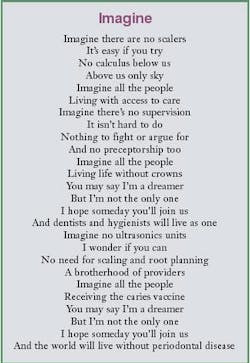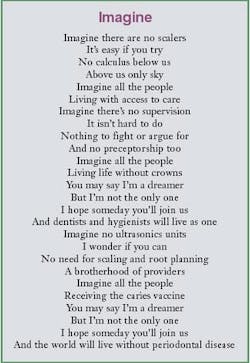Imagine the future
By Kristine A. Hodson
My apologies to John Lennon for changing the lyrics to his popular song, "Imagine." But how would your hygiene world change, if you awakened tomorrow and no longer needed to use instruments in your job? Imagine if what we currently do becomes irrelevant over the years. Imagine a patient going to a lab and having a blood sample drawn, a saliva DNA swab, imaging, and a urinary sample. Then, a read-out of his genetic deficiencies and/or disease susceptibility will be produced, along with "oral health orders" for appropriate oral health treatment.
If we embrace our role as prevention specialists — and advances in technology continue at the pace it has over the past decade — then imagining dental hygiene without our current clinical duties and instruments becomes imaginable — and quite probable.
Consider these oral health truths and trends:
• Dental offices are not favorite places for people to visit. We hear it all the time, "It's not personal ... but I hate coming to the dentist."
• The majority of dentists fear hygiene autonomy or do not understand it. The few doctors who are self-assured in their own talents and abilities are not threatened by the interdependence of a collaborative team. They understand that there are access to care issues and an underserved population. They acknowledge that when hygienists are able to reach these currently uncared for populations, they will need a referring dental facility. Our professions will be able to serve more people. Many realize that patient abundance will flourish in dentistry if egos are replaced with visionary voices.
• The objective is intervention, prevention, and health promotion. How will the newer, smarter medicine, medicaments, vaccines, and even chewing gum reduce or prevent plaque and calculus formation? (If calculus does not form, hygienists will not have to remove it.)
• Genetic engineering, biotechnology, regenerative medicines, and bioinformatics will change everything during the next 15 years.
• Trends in the collaboration between complementary or unconventional and cross-disciplinary fields will change everything during the next 15 years.
• The new breed of patients will change everything during the next 15 years.
An increasing number of traditional organizations, policymakers, and providers are taking a second look at what the field of oral health care will resemble in the future. For example, the American Dental Hygienists' Association (ADHA) has identified a workgroup to develop a document on the vision of the "Future of Dental Hygiene" in the United States. The project will take place over a three-year period, beginning FY 2002/2003.
Soliciting input
During the first year (2002/2003), ADHA has solicited input from dental hygienists across the country, in the following venues: ADHA 2002 Strategic Planning; ADHA Council Meetings; and the ADHA Constituent Officer's Workshops. In addition, members have been informed about the project and may contribute ideas through Access, Journal of Dental Hygiene, and the ADHA Web site.
The report will focus on a vision of the future of the profession, not the future of ADHA, the organization. The sections of the report are: practice and technology; dental hygiene education; research; public health; licensure and regulation; access to oral health care; and federal and state government involvement. With this charge — and with member involvement — anything is possible.
The following are some of my thoughts on hygiene of the future. Imagine that patients no longer come to you for "a cleaning." Instead, they visit you yearly, similar to annual physical or females' OBGYN appoints. Hygienists are part of the medical facility. The hygiene practitioners order oral-based diagnostic tests, using blood work, saliva, sub-gingival essays, and oral tissues samples when needed. These samples are sent to a laboratory and analyzed by an oral hygiene technician (OHT). The OHT sends the hygiene practitioner the results and the patient returns to the medical office for counsel and appropriate referrals. These appointments are not the traditional 45 to 60 minutes; they are 10 to 15 minutes, similar to the current medical model.
In addition, hygienists will work within a gynecological facility and see expectant mothers as soon as it is confirmed that they are pregnant. Expectant mothers will visit their oral health hygienists as part of their pre-natal care. And hygienists will work within pediatrician's offices. They will counsel and see children as early as their two-week visit. In addition, medical hygienists will administer the periodontal and caries vaccines to children by three years of age, as part of their childhood vaccination series (similar to DDT vaccines or the Hepatitis B vaccines).
Hygienists will recommend hand-held fluorescence wands, instead of power toothbrushes. These wands plug into any home computer and the parent can perform a caries examination at home. The results are electronically e-mailed to the medical hygienist, who guides them on the appropriate over-the-counter product or prescription. Flip another switch on the wand, and the consumer can "clean their teeth." Turn the toggle switch again, and patient can use the same hand held device to take a picture of a broken tooth, abscess, or anything in the mouth and e-mail it to the medical hygienist for a referral to the appropriate "Tooth Bank."
And say goodbye to the Tooth Fairy. Once a deciduous tooth is lost, it will no longer go under the pillow. Instead the tooth is taken to the "Tooth Bank" and it is preserved for future use. The child, as he or she grows into adulthood, can make withdrawals from the account, with a referral from a hygienist, of course. The "Tooth Bank" will use tissue engineering technology and the stem cells from the deciduous tooth. The hygienists who work in these "Tooth Banks" will manipulate the complex structures and create living teeth or a section of the tooth that can be transplanted into an oral cavity. No need for drills or restorative materials. This places a whole new dynamic on smile re-designs. Patients will no longer need veneers or crowns to create new smiles — just altered stem cells.
How would your hygiene world change if health centers, exercise centers, spas, or salons featured "hygiene stations" and members or patients could use a device on their own to remove any stains or buildup? Or what if an OHT programs a machine and oversees the work from behind a wall in these facilities? Again, these would be "smart ultraviolet devices." Once the unit is correctly programmed, the machine does the work via a laser or ultrasonic light. No damage occurs to the skin or tissue; the machine is programmed only to dissolve stain and calculus, or sterilize the periodontium.
The bottom line is that hygiene is changing and oral health advances are occurring daily. If our profession tightly holds onto our identity based on scalers and functions that surround the "removal of plaque or calcified deposits," we will miss the bigger picture.
The reality is that, when manufactures produce an oral device that can safely remove stain, plaque, or calculus or determine a cavity, they will sell it directly to the customer. It's pure economics. A recent example is whitening. Who predicted such a massive OTC whitening market? Obviously, only a few futuristic dental manufacturers. Now, many companies seem to want a piece of that billion-dollar pie. It's basic supply and demand. The consumer market is bigger and has the possibility to generate more revenues than the professional dental market.
We now have increased opportunities to share with the medical and public communities what hygienists know — called "intellectual assets" — about connecting oral health and total health. Let go of the sanctity of our hand or power instruments and look for openings that use our minds vs. only clinical skills. Imagine the future of hygiene.
Kristine A. Hodsdon, RDH, BS, is an international speaker, author, and software developer. She is the author of Demystifying Smiles: Strategies for the Dental Team. The book is available online at www.pennwell-store.com. She can be contacted about speaking or coaching at [email protected]. Visit her on the Web at www.reachhygiene.com.

